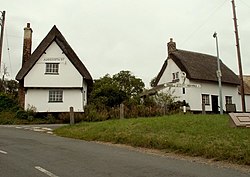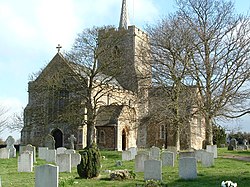Thriplow
| Thriplow | |
| Cambridgeshire | |
|---|---|
 Cottages at Thriplow | |
| Location | |
| Grid reference: | TL438467 |
| Location: | 52°6’0"N, 0°6’0"E |
| Data | |
| Population: | 847 (2001) |
| Post town: | Royston |
| Postcode: | SG8 |
| Dialling code: | 01763 |
| Local Government | |
| Council: | South Cambridgeshire |
| Parliamentary constituency: |
South Cambridgeshire |
| Website: | Thriplow.org.uk |
Thriplow (pronounced treeplow) is a village in the very south of Cambridgeshire, eight miles south of Cambridge. It gives its name to the Thriplow Hundred of the county.
The village appears as Tripelan in around 1050 and as Trepeslau in the Domesday Book. The name appears to be the Old English Trippan hlaw or Tripes hlaw or similar, meaning "Trip's (or Tryppa's) hill" after the tumulus lying just southeast of the church.[1][2]
Contents
Church
There has been a church in Thriplow since at least the 12th century. In 1284 the church was given to Peterhouse, Cambridge and the first recorded vicar, John de Hyndrayngham, was installed in 1299.[3]
The parish church of St George (previously dedicated to All Saints until the 19th century) dates from the late 13th century and consists of a chancel with north vestry, north and south transepts, a central tower with short spire, and a nave with south porch. The tower and spire date from the 14th century. The south porch was rebuilt by Gilbert Scott in 1877.[3]
The records of William Dowsing's visitation in 1644 records that the church has a screen, which was duly pulled down.[3]
The parish is now held with that of Fowlmere and no vicar has lived in Thriplow since 1936.[3]
History
Thriplow stands by the old London to Cambridge coaching road (now the B1368) and the ancient Icknield Way, on the stretch between Royston and Newmarket (now the A505). The presence of tumuli in the south of the parish suggest an Iron Age settlement and a barrow to the east of the village contains a Bronze Age burial. The Icknield Way to the south of the village was probably an important factor in the establishemt and growth of the village.[3] The tumuli or one of them gave the village its name in Anglo-Saxon times.
In 1647 the New Model Army camped on Thriplow Heath (often referred to in contemporary accounts as 'Triploe Heath') after its refusal to disband during its dispute with Parliament.[3]
Thirteen Thriplow men are recorded to have perished in the First World War and three in the Second World War.[4]
In recent times the hamlet of Heathfield has built up in the south east of the parish alongside the Imperial War Museum Duxford, with most of the housing dating from the 2000s. Its population (c600) is now larger than that of Thriplow village (c440).[2]
The village
Thriplow has one public house, The Green Man, which has been open since the first half of the 19th century. Former pubs include The Fox, on the east side of Church Street, open in the early 19th century and which burned down in 1919. The Red Lion at the north end of Middle Street burned down around 1941 with the site taken by the village hall in 1958.[3]
The village shop last operated as an independent commercial concern between 1997 and 2000. After that there were several attempts to continue the shop as a business which failed, and the management was finally taken over by the Thriplow Village Shop Association in June–July 2007. The village is also home to a park, a primary school, a village hall and a cricket ground.
The smithy on the village green was still open in the early 1960s but was given to the village in 1964 as a museum.[3] It opens twice a year when the blacksmith gives a demonstration of traditional skills.
Thriplow also contains two 'sites of special scientific interest'; Thriplow Meadows and Thriplow Peat Holes.[5]
The Thriplow Daffodil Weekend
The tradition started in 1969 in an attempt to raise money for repairing the church and has run each year since (except during the foot-and-mouth restrictions of 2001). The event is organised by the Daffodil Weekend Trust and raises funds for a different charity each year, with the charity for 2014 being Home Start. There are numerous attractions during the weekend including heavy horses giving dray rides, children’s entertainment, sheep dogs working, open gardens and stalls. New for 2014 was a miniature steam railway offering rides to visitors on the Cricket Meadow, and over the last two years, the weekend has hosted a Taste of Thriplow. Located on Peggs Close, the Taste of Thriplow site is devoted to local food and drink heroes and in 2014, the addition of a beer tent and local musicians was very well received by visitors.
Outside links
| ("Wikimedia Commons" has material about Thriplow) |
References
- ↑ A. D. Mills (2003). "A Dictionary of British Place-Names". http://www.encyclopedia.com/doc/1O40-Thriplow.html.
- ↑ 2.0 2.1 Thriplow Website
- ↑ 3.0 3.1 3.2 3.3 3.4 3.5 3.6 3.7 A History of the County of Cambridge and the Isle of Ely, Volume 8
- ↑ Roll Of Honour
- ↑ Natural England - Sites of Special Scientific Interest
